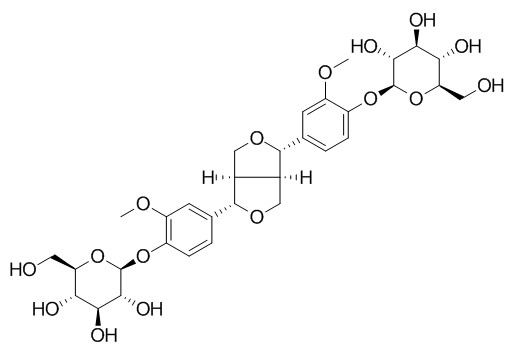Pinoresinol diglucoside
Pinoresinol diglucoside is a putative α-glucosidase inhibiting compound, has antihypertensive activity. It is a heat shock factor 1 inducer, increased expression of HSF1 by a factor of 1.041 at 3 μM.
Inquire / Order:
manager@chemfaces.com
Technical Inquiries:
service@chemfaces.com
Tel:
+86-27-84237783
Fax:
+86-27-84254680
Address:
1 Building, No. 83, CheCheng Rd., Wuhan Economic and Technological Development Zone, Wuhan, Hubei 430056, PRC
Providing storage is as stated on the product vial and the vial is kept tightly sealed, the product can be stored for up to
24 months(2-8C).
Wherever possible, you should prepare and use solutions on the same day. However, if you need to make up stock solutions in advance, we recommend that you store the solution as aliquots in tightly sealed vials at -20C. Generally, these will be useable for up to two weeks. Before use, and prior to opening the vial we recommend that you allow your product to equilibrate to room temperature for at least 1 hour.
Need more advice on solubility, usage and handling? Please email to: service@chemfaces.com
The packaging of the product may have turned upside down during transportation, resulting in the natural compounds adhering to the neck or cap of the vial. take the vial out of its packaging and gently shake to let the compounds fall to the bottom of the vial. for liquid products, centrifuge at 200-500 RPM to gather the liquid at the bottom of the vial. try to avoid loss or contamination during handling.
J Biotechnol.2020, 318:10-19.
Phytochemistry Letters2017, 449-455
Redox Rep.2024, 29(1):2392329.
Res Rep Urol.2022, 14:313-326.
Phytomedicine.2021, 93:153789.
Biomed Pharmacother.2023, 163:114785.
Journal of Physiology & Pathology in Korean Medicine.2018, 32(2): 106-112
Phytomedicine.2021, 2(82):153452
Front Aging Neurosci.2019, 11:230
Int J Mol Sci.2024, 25(18):9909.
Related and Featured Products
Chem Biodivers. 2013 Jul;10(7):1322-7.
Heat shock factor 1 inducers from the bark of Eucommia ulmoides as cytoprotective agents.[Pubmed:
23847077]
The barks of Eucommia ulmoides (Eucommiae Cortex, Eucommiaceae) have been used as a traditional medicine in Korea, Japan, and China to treat hypertension, reinforce the muscles and bones, and recover the damaged liver and kidney functions.
METHODS AND RESULTS:
Among these traditional uses, to establish the recovery effects on the damaged organs on the basis of phytochemistry, the barks of E. ulmoides have been investigated to afford three known phenolic compounds, coniferaldehyde glucoside (1), bartsioside (2), and feretoside (3), which were found in the family Eucommiaceae for the first time. The compounds 1-3 were evaluated for their inducible activities on the heat shock factor 1 (HSF1), and heat shock proteins (HSPs) 27 and 70, along with four compounds, geniposide (4), geniposidic acid (5), Pinoresinol diglucoside (6), and liriodendrin (7), which were previously reported from E. ulmoides. Compounds 1-7 increased expression of HSF1 by a factor of 1.214, 1.144, 1.153, 1.114, 1.159, 1.041, and 1.167 at 3 μM, respectively.
CONCLUSIONS:
Coniferaldehyde glucoside (1) showed the most effective increase of HSF1 and induced successive expressions of HSP27 and HSP70 in a dose-dependent manner without cellular cytotoxicity, suggesting a possible application as a HSP inducer to act as cytoprotective agent.
J. Korean Soc. Appl. Bi., 2014, 57(4):473-9.
Pinoresinol Diglucoside is Screened as a Putative alpha-Glucosidase Inhibiting Compound in Actinidia arguta leaves[Reference:
WebLink]
Actinidia arguta leaves are consumed as a popular food material in Korea and have been reported to exert beneficial effects on humans due to its constituent polyphenolic compounds.
In this study, the alpha-glucosidase inhibitory compounds in A. arguta were screened and identified through alpha-glucosidase-guided fractionation and metabolomic analysis.
METHODS AND RESULTS:
The 50% ethanol extracts of A. arguta showed strong inhibitory effect (32.6%), which was comparable to acarbose as a positive control (30.0%). Through multiple steps of fractionation, Pinoresinol diglucoside and fertaric acid were identified as the major potent compounds in A. arguta inhibiting alpha-glucosidase activity by liquid chromatography mass spectrometry analysis and metabolomic comparison. Particularly, because pinoresinol and its glycosides have been demonstrated as alpha-glucosidase inhibitory agents, Pinoresinol diglucoside was proposed to be a putative key compound for alpha-glucosidase inhibition in A. arguta.
CONCLUSIONS:
This is the first study demonstrating the anti-diabetic effect of a pinoresinol-containing fraction of A. arguta and would be useful for its application as a natural alpha-glucosidase inhibitor.
Appl Microbiol Biotechnol. 2012 Feb;93(4):1475-83.
Structure identification and fermentation characteristics of pinoresinol diglucoside produced by Phomopsis sp. isolated from Eucommia ulmoides Oliv.[Pubmed:
22048615]
Pinoresinol diglucoside (PDG) is the important antihypertensive compound in Eucommia ulmoides Oliv., a traditional Chinese herb medicine. The research objective was to certify the possibility of producing PDG through fermentation.
METHODS AND RESULTS:
PDG-producing endophytic fungi were isolated from E. ulmoides Oliv., and the highest PDG-yielding (11.65 mg/L) isolate, XP-8, was identified as Phomopsis sp. according to the morphological characteristics and the phylogenetic tree constructed on the basis of the gene sequence in the internal transcribed spacers district.
The microbial PDG was isolated by using S-8 resin and purified to a purity of 98.7% using preparative high-performance liquid chromatography (HPLC). Information obtained from the UV spectrum (277 and 227 nm, in water solution), infra-red spectrum (3,428; 2,930; 2,877; 1,637; 1,600; and 1,513; 1,460; 1,421; 1,269; 1,223; 1,075; 658 cm(-1), in powder), molecular weight (682 Da, measured using HPLC-electrospray ionization mass spectrometry (ESI/MS) and tandem mass spectrometry), and nuclear magnetic resonance analysis show the microbial PDG is (+)-1-pinoresinol 4,4'-di-O-β-D-glucopyranoside, same as the plant-derived PDG. The microbial PDG is stable in pH range from 3 to 11 but less stable at temperature higher than 90 °C and in light exposure.
CONCLUSIONS:
During the fermentation, PDG production outside cells starts at the later stage of cell growth when the residual sugar in the medium was low. The study reveals the possibility for production of PDG by fermentation.



